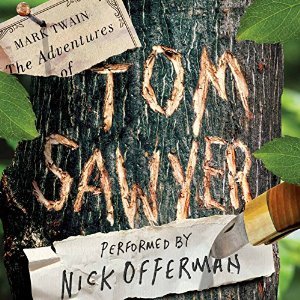- The Good: A mischievous scamp’s boyhood adventures
- The Bad: Dated offensive racism
- The Literary: A literary classic unto itself
Mark Twain is an American treasure and a delight. To this day, his work resonates with humor, satirical social criticism, and the truths of childhood. In The Adventures of Tom Sawyer, he captures the longing to be free from adult rules, the excitement of nighttime visits to the cemetery and haunted houses, and a naïve understanding of consequences. In Mark Twain’s first solo novel, the clever orphan Tom Sawyer has many adventures, often accompanied by his friend Huckleberry Finn.
When Tom skips school to go swimming, his guardian Aunt Polly sets him to whitewashing her fence for an entire day as punishment. In one of the most famous scenes of American literature, Tom uses reverse psychology to trick the neighborhood children into whitewashing the fence for him, even receiving little treasures in exchange for the chance try whitewashing for themselves. Tom, you little rascal!
And that’s just the beginning. Tom has a number of adventures, from pursing the new girl in town Becky Thatcher, to running away to live as pirates on an island in the Mississippi, to crashing to own funeral, to eventually getting lost in a cave with Becky for several days. But the episodic scenes are held together by a gruesome death. Early in the story, Tom and Huck witness a midnight murder in the graveyard, and are the only ones who know the truth when the wrong man is jailed.
This book is so fun and so funny, I smiled nearly the entire time as I listened to Nick Offerman’s terrific narration. Nearly, because two significant racist elements stand stark against the carefree backdrop of the story. First, the n-word is rampant. Second, the villain and murderer of the piece is Injun Joe, a malevolent caricature of a half-breed Native American whose evil is blamed on his Indian blood.
I still highly recommend reading Mark Twain’s works. William Faulkner called him the Father of American Literature. And the more you read of his writings and his life, the more you understand that Twain wrestled with racism, a struggle that showed up in his work as early as his next book, Adventures of Huckleberry Finn. When you let your children read these classics, have conversations with them about how Tom and Huck could use such reprehensible language.
Highly recommended as an American classic!
